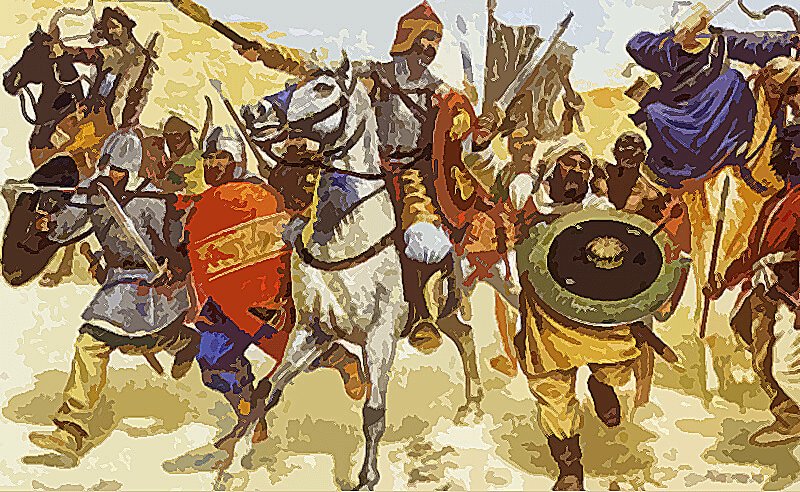Maratha in Rajasthan is a significant topic in Rajasthan History, reflecting the expansion of Maratha power into the region during the 18th century. Key events include the Reasons for Maratha Arrival in Rajasthan, the Battle of Mandsaur, and the Hurda Conference. The Marathas played active roles in Bundi, Jaipur, and Marwar, influencing local politics and administration. The Consequences of Maratha Intervention were far-reaching, reshaping Rajput relations and weakening regional autonomy.
Maratha in Rajasthan

To analyze the relationship, impact, and consequences of the Marathas on Rajputana, we are dividing the topic into the following concise sections:
Reasons for Maratha Arrival in Rajasthan
- Decline of Mughal Power : After Aurangzeb, weakening Mughal authority created a political vacuum in North India.
- Expansionist Policy of Peshwa Baji Rao-I : Aimed to extend Maratha dominance in North India (Attock to Cuttack)
- Weak Rajput States : Ongoing succession disputes and lack of unity made Rajputana susceptible to external intervention.
- Tributary Gains (Chauth & Sardeshmukhi) : Marathas targeted Rajasthan for revenue extraction through forced tributes.
- Invitations by Rajput Rulers : Internal rivalries led Rajput kings to seek Maratha military support (e.g., in Bundi, Marwar, Jaipur).
- Geopolitical Importance : Rajasthan offered strategic access to Delhi, Punjab, and important trade corridors.
Initial Contact with the Marathas :
- Rajputs first encountered the Marathas when Aurangzeb sent Jaswant Singh of Jodhpur and Jai Singh of Amer to suppress Shivaji in the Deccan.
- Though unsuccessful, they admired Shivaji’s independence, his efforts to preserve Hindu culture, and his resilience against Aurangzeb.
- These interactions remained limited to the Deccan until Peshwa Baji Rao-I launched an aggressive northern expansion campaign.
Cordial Relations with the Marathas :
- Sawai Jai Singh of Jaipur secretly supported the Marathas in their Malwa campaign.
- His goal was to weaken Mughal control in Malwa and extend his own influence in the region.
Maratha Expansion into Rajasthan :
- By the late 17th century, the Mughal Empire’s decline created opportunities for new powers.
- In 1720 CE, Peshwa Baji Rao adopted a systematic strategy to expand northward, focusing on Malwa and Gujarat.
- Sawai Jai Singh, appointed as Malwa’s Subedar, initially resisted but could not stop the Marathas. Malwa gradually came under their control.
Maratha Raids in Rajasthan :
- The Marathas began sporadic raids in Kota, Bundi, Mewar, and Marwar.
- In 1726, Baji Bhim raided Mewar and collected Chauth (tax).
- In 1728, Bajirao forced the rulers of Dungarpur and Banswara to pay tribute.
- They entered Rajasthan through Mukandara Pass and routes from Gujarat via Idar and Jalore.
Battle of Mandsaur (1733) :
- Jai Singh was reappointed governor of Malwa in 1732.
- In 1733, Maratha leaders Malhar Rao Holkar and Ranoji Shinde surrounded Jai Singh at Mandsaur.
- They cut off his supplies, forcing him to negotiate. Jai Singh paid ₹6 lakhs and Ceded 38 parganas as Chauth.
- After this, Marathas consolidated their control over Malwa.
Maratha Penetration in Rajasthan –
Marathas’ Role in Bundi :
- The Marathas established Malwa as their base for raids into Rajputana.
- Sawai Jai Singh expelled Budh Singh to install his son-in-law Dulel Singh on Bundi’s throne.
- Budh Singh sought Maratha support, and Malhar Rao Holkar reinstated him.
- However, Jai Singh again expelled Budh Singh and restored Dalel Singh.
- After Budh Singh’s death, his widow sought Holkar’s help, who defeated Jaipur’s forces and reinstated Ummed Singh on Bundi’s throne.
- As payment for his services, Holkar gained control over Patan.
Hurda Conference (1734)
- Realizing Mughal weakness against the Marathas, Rajput leaders convened at Hurda to form a united front.
- Key participants: Sawai Jai Singh (Jaipur), Maharana Jagat Singh (Mewar), Abhay Singh (Jodhpur), Dulel Singh (Bundi), Durjan Sal (Kota), and others.
- An agreement to resist the Marathas was signed on 17th July 1734.
Maratha Role in Jaipur :
- Sawai Jai Singh passed away on 21st September 1743, leading to a succession dispute between his sons ( Reason – remember Debari pact now)
- Ishwari Singh initially gained recognition from the Mughal emperor and neighboring rulers, including the Peshwa.
- Maharana Jagat Singh of Mewar along with Durjansal of Kota opposed Ishwari Singh and supported Madho Singh, sparking conflicts.
- Ishwari Singh ceded Tonk to Madho Singh, but this failed to satisfy him.
- In 1744, Maharana Jagat Singh allied with Madho Singh and attacked Jaipur. Ishwari Singh sought Maratha support to resist.
- Battle of Rajmahal (1747): Maharana now sought Maratha support and concluded agreement with Malhar Rao Holkar of payment of two lakh rupees. Ishwari Singh defeated the combined forces of Kota, Shahpura, and Mewar.
- Battle of 1748: Ishwari Singh was rooted out and had to promise a heavy bribe to Maratha Sardar Gangn Dhar to save the destruction. He fails to pay the money promise and commit suicide. Holkar installed Madho Singh on the throne.
Maratha Intervention in Marwar :
- Ram Singh vs. Vijay Singh
- Ram Singh became the ruler of Marwar on 13th July 1749, but his uncle Bakhat Singh disputed his accession.
- Bakhat Singh defeated Ram Singh at Luniawas (27th November 1750) and took the throne.
- After Bakhat Singh’s death in 1752, his son Vijay Singh succeeded him.
- Ram Singh, backed by Jaipur’s Sawai Madho Singh, sought Maratha assistance.
- Marathas supported Ram Singh and attacked Vijay Singh in 1753, installing Ram Singh as ruler.
- Maratha demands led to hatred among locals, culminating in the murder of Jayappa Sindhia (1755).
- The Marathas switched allegiance, supporting Vijay Singh.
- With Malhar Rao Holkar’s help, Vijay Singh ended the conflict, and Ram Singh lived in exile until his death in 1772.
Maratha Intervention in Jat Affairs :
- Jawahar Singh vs. Nahar Singh
- Madho Singh sought help from Holkar and Sindhia to counter Jawahar Singh’s actions.
- Despite initial setbacks, Jawahar Singh allied with Vijay Singh of Marwar to resist Maratha interference.
Consequences of Maratha Intervention –
- Political:
- Erosion of Rajput Sovereignty – Frequent interference in succession and administration.
- Rise in Internal Conflicts – Marathas often supported rival factions, fueling instability.
- Shift of Rajputs toward British Support – To counter Maratha pressure, alliances with EIC increased.
- Economic:
- Heavy Taxation – Chauth and Sardeshmukhi drained the local economy.
- Looting and Plunder – Repeated raids devastated rural and urban wealth.
- Military & Administrative:
- Rise of Maratha Garrisons and Influence – Marathas began posting troops and officers in Rajput states.
- Decline of Centralized Rajput Power – Rajputana became a contested and fragmented political space.
Conclusion :
The Marathas rose to prominence under Shivaji’s leadership, challenging the Mughal Empire. After Aurangzeb’s death, the Mughal decline provided an opportunity for the Peshwas to expand northward, establishing control over Malwa and Gujarat. Rajasthan’s proximity to these regions enabled the Marathas to enter Rajputana. Initially, they made raids but were later invited by Rajput rulers like Bundi, Jaipur, Jodhpur, and Mewar to settle succession disputes, in exchange for money or territory.
Over time, the Marathas shifted from being mediators to demanding tributes and ravaging lands. Their intervention ended with the rise of British authority. From 1803 to 1823, all Rajput states, including Jaipur, Jodhpur, and Mewar, signed subsidiary treaties with the British, marking the Marathas’ decline in Rajasthan.
